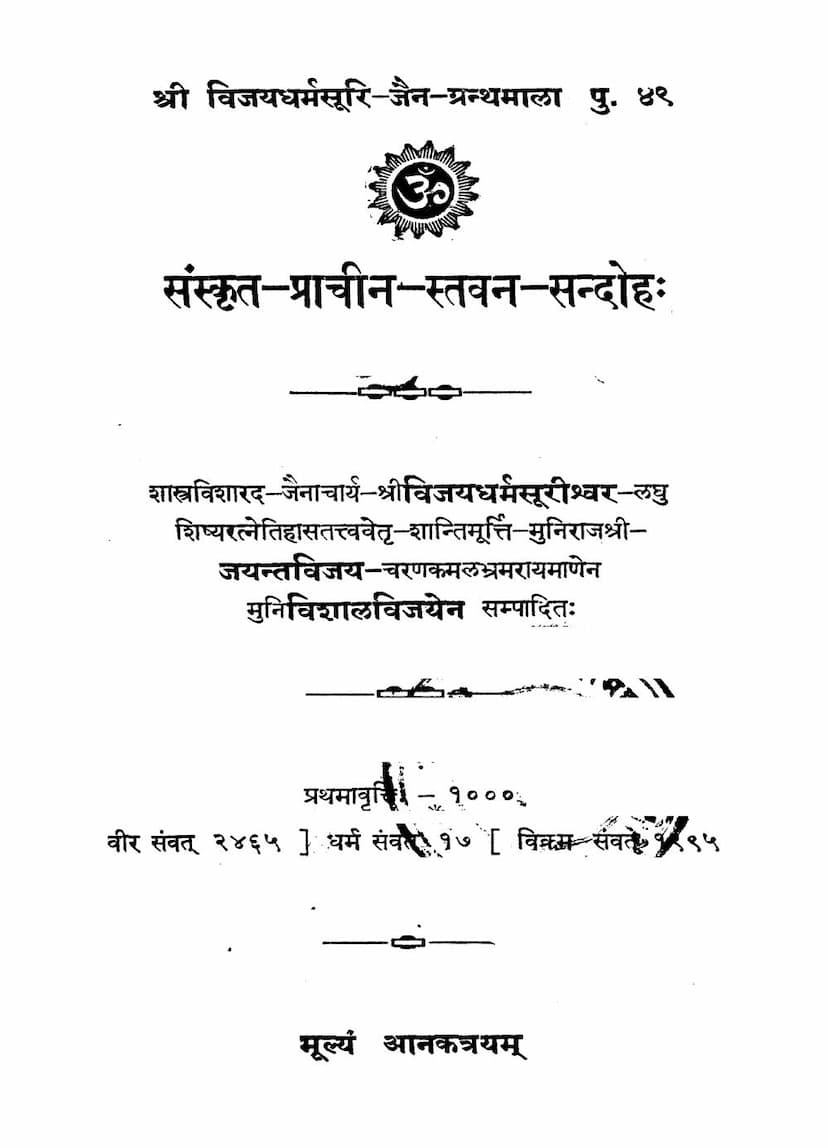Sanskrit Prachin Stavan Sandoh
Added to library: September 2, 2025

Summary
Here's a comprehensive summary of the Jain text "Sanskrit Prachin Stavan Sandoh," based on the provided pages:
Book Title: Sanskrit Prachin Stavan Sandoh (Collection of Ancient Sanskrit Stotras/Hymns)
Author(s)/Editor: Compiled by Muni Vishalvijay, disciple of the respected Muni Jayantvijay, who was a junior disciple of the scholar Jainacharya Shri Vijaydharmasurishwarji.
Publisher: Shri Vijaydharmasuri Jain Granthmala, Chhota Sarafa, Ujjain (Malwa).
Publication Details:
- This is the 49th publication of the Shri Vijaydharmasuri Jain Granthmala.
- First Edition: 1000 copies.
- Published in Veer Samvat 2465, Dharma Samvat 17, Vikram Samvat 1995.
- Price: Three Annas (a small monetary unit).
- The publication was made possible through a donation from Shravika Manghibai, in memory of her mother Pradhanbai.
Core Content and Purpose: The book is a collection of ancient Sanskrit hymns (Stotras) dedicated to the Tirthankaras (Jain spiritual leaders). The compiler, Muni Vishalvijay, states in the preface that he had not previously encountered printed collections of Sanskrit hymns, although many other Jain texts existed in print and manuscript.
Inspiration and Source Material: The compilation was inspired by Muni Vishalvijay's guru, Muni Jayantvijay, who was the author of the well-known work "Aboo." Muni Jayantvijay had diligently collected various hymns in different languages related to the sacred Mount Abu. From these collected manuscripts, a specific ancient five-leaf handwritten copy, written in clear script and related to the Shri Vijaydharm-Lakshmi-Gyan Mandir in Ugrapur (Agra), was found. This manuscript contained a hymn to Arbuda-chala (Mount Abu) along with other beautiful and melodious Sanskrit hymns, some adorned with Yamaka (rhyming) and Anupras (alliteration) figures of speech. Upon seeing these hymns, the guru deemed them worthy of publication and instructed Muni Vishalvijay to undertake their compilation.
Dating of the Hymns: While the exact author and date of composition for many hymns could not be definitively determined due to a lack of explicit mention in the manuscripts, the compiler estimates that these hymns are older than Vikram Samvat 1515 (1515 AD). This estimation is primarily based on the hymn to Arbuda-chala, which mentions only three temples at the site. Historical records indicate that a fourth temple, belonging to the Kharatar Gaccha, was consecrated in Vikram Samvat 1515. If the hymn had been composed after this, it would likely have included a reference to the fourth temple as well.
Compilation Challenges and Appeal to Readers: Muni Vishalvijay acknowledges that no other manuscript of this collection was available besides the single one he secured. He also admits that this single manuscript was not entirely perfect. Therefore, he expresses humility regarding any errors that might have inadvertently crept into the compilation due to his own lack of knowledge, confusion, or oversight. He appeals to the learned readers to kindly correct any such inaccuracies they might find.
Structure of the Hymns: The collection primarily consists of 37 hymns, each composed of five verses (श्लोक). The meter used for most of these hymns is the Anushtubh meter. This structural consistency leads the compiler to infer that they might have originated from a single author.
Content Highlights (Examples of Hymns to Tirthankaras): The book includes hymns dedicated to various Tirthankaras, starting from the first:
- Shri Rishabhastavanam (Hymn to Rishabhadeva)
- Shri Ajitastavanam (Hymn to Ajitnatha)
- Shri Shambhavastavanam (Hymn to Sambhavanatha)
- Shri Abhinandanastavanam (Hymn to Abhinandananatha)
- Shri Sumatistavanam (Hymn to Sumatinatha)
- Shri Padmaprabhastavanam (Hymn to Padmaprabha)
- Shri Suparshvastavanam (Hymn to Suparshvanatha)
- Shri Chandraprabhastavanam (Hymn to Chandraprabha)
- Shri Suvidhistavanam (Hymn to Suvidhinatha)
- Shri Shitalastavanam (Hymn to Shitalanatha)
- Shri Shreyansastavanam (Hymn to Shreyansanatha)
- Shri Vasupujyastavanam (Hymn to Vasupujya)
- Shri Vimalastavanam (Hymn to Vimalanatha)
- Shri Anantastavanam (Hymn to Anantanatha)
- Shri Dharmanathastavanam (Hymn to Dharmanatha)
- Shri Shantinathastavanam (Hymn to Shantinatha)
- Shri Kunthunathastavanam (Hymn to Kunthunatha)
- Shri Arastavanam (Hymn to Aranatha)
- Shri Mallistavanam (Hymn to Mallinatha)
- Shri Munisuvratastavanam (Hymn to Munisuvrata)
- Shri Naminathastavanam (Hymn to Naminatha)
- Shri Neminathastavanam (Hymn to Neminatha)
- Shri Parshvastavanam (Hymn to Parshvanatha)
- Shri Veerastavanam (Hymn to Mahavir)
- Shri Shatruñjayastavanam (Hymn to Shatruñjay)
- Shri Girinarastavanam (Hymn to Girnar)
- Shri Arbudaadristavanam (Hymn to Mount Abu)
- Shri Stambhanajinastavanam (Hymn to the idol at Stambhan)
- Shri Ashtapadastavanam (Hymn to Ashtapada)
- Shri Sametajinastavanam (Hymn to Samet Shikhar)
- Shri Shaashvatajinastavanam (Hymn to Eternal Jinas)
- Shri Shaashvatashashtatajinastavanam (Hymn to Eternal and Non-eternal Jinas)
- Shri Trikalajinastavanam (Hymn to Jinas of the Past, Present, and Future)
The text also includes various Shuddhipatra (correction notices) for common errors found in the text and lists of other publications by the same Granthmala, covering a range of topics and languages (Gujarati, Hindi, English, Sanskrit). The latter pages highlight other works compiled or authored by Muni Vishalvijay, Muni Jayantvijay, and Muni Vidyavijay, showcasing their prolific literary contributions to Jain literature and scholarship.
In essence, Sanskrit Prachin Stavan Sandoh is a valuable academic and devotional compilation of ancient Sanskrit hymns, meticulously gathered and presented to preserve and disseminate this significant aspect of Jain heritage.